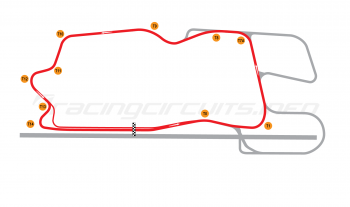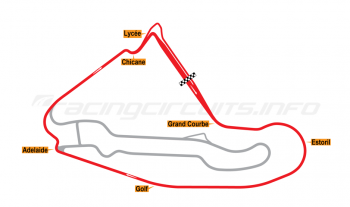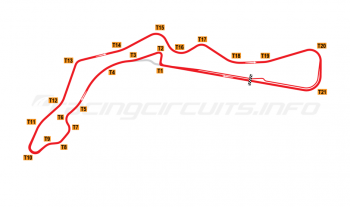Oran Park
Circuit Overview
Oran Park Raceway was a thriving hub for motor racing activity on the outskirts of Sydney from its inception in 1962 through to its closure in 2010.
Located at Narellan, the track grew from a small club circuit into one known the world over, thanks to it's figure-of-eight layout and inclusion in numerous racing games and simulators.
Since its closure in 2010 it has been developed into housing and there is little to show there was ever a circuit here, other than some racing-related street names.
Circuit History
In the early 1960s, Australian motorsport was seemingly on a high. Jack Brabham was Formula One World Champion and the creme of the world's motorsport elite was regularly competing on home shores thanks to the booming Tasman Series. Names such as Amon, Clark, Hill, Stewart and Surtees were regularly on track at a ready crop of circuits built to international standards and the crowds seemingly loved it.
Beneath the surface, however, the picture was not so rosy. Clubman racing was in something of a crisis, with facilities such as Dooen, Gnoo Blas, Mount Druitt and Catalina Park all closing. While the established stars had plenty of scope for thrills and spills, the enthusiastic amateur racer was having a much tougher time of it, with fewer and fewer opportunities to take part in the sport they loved.
Club racers in Sydney were no different and began looking for a new venue they could call home. Warwick Farm was very much a circuit for the professional racer, so something else was required in order for racing to flourish. In 1961, a group of enthusiasts identified a parcel of land outside Camden which looked like having good potential. Little more than farmland, with the encouragement of its owner. Dan Cleary, a rudimentary one mile circuit was created.
Rough but ready
And basic was definitely the order of the day. The track surface was oil-sealed dirt and rough, while there were no real facilities to speak of, save for an old double decker bus which served as the timekeeping stand and commentary position. Create it and they will come seemed to have been the motto - and come they did. On Sunday 18 February 1962, the newly-created Oran Park was ready for its first meeting, complete with an enormous 18 races held over the course of the first day.
Necessarily the races were fast and furious, with the short, twisty course featuring significant elevation changes to add to the challenge. The longest race was just 12 miles in total, while the fastest lap was set by a near home-built Nota, powered by a 1000cc four-cylinder Ford engine.
That original track surface was oil-sealed dirt and proved so rough and prone to breaking up that standing starts weren't even possible. Races had to be started behind a pace car, a Mercedes 190SL driven by its owner, Dave Millar, who was himself known for the occasional spin ahead of the field when his enthusiasm exceeded his driving talent...
The loose gravel that was subsequently thrown up proved an issue for those pioneering early competitors, so much so that the race organisers agreed to refund the many broken windscreens from the start fees.
Perhaps because it was designed by racers, Oran Park was nonetheless a hit with competitors and spectators alike. Some 2,000 paying punters turned out for that first event and were left thrilled by unprecedented views of the action they enjoyed. The best place to enjoy the spectacle was pressed up against the fence in the paddock, where the cars whizzed by through the final turn within touching distance. Better still, almost the whole circuit was visible from most vantage points, ensuring none of the action was missed.
Those first steps for the 'nursery course' quickly bred further success and in late 1963, the original promoters, the Singer Car Club, became the far more appropriately-named New South Wales Road Racing Club. The track was soon modified, with the final corner extended and modified and the kind in the main straight removed as the course was reprofiled and the surface properly sealed.
Bit by bit, the circuit grew in stature. During those early years, the lap record see-sawed between Frank Matich in his Lotus 19 sportscar and Leo Geoghegan in a variety of Lotus open-wheelers. Matich's opening salvo of 49 seconds was soon bested to 46.4 seconds, before Niel Allen and John Harvey also set quick times. In 1972, Matich took it back again, a sensational 39 second lap in his own Matich A50. So quick was the time that the record stood for 11 years before Andrew Miedecke shaved just one-tenth of a second off it to leave it at 38.9 seconds.
Outright lap times were not necessarily what the punters paid most attention to at Oran Park, however; it was the close, hard racing that drew the most interest, with the touring car battles proving the most exciting. As early as 1964 Pete Geoghegan's Lotus Cortina and a clutch of FJ Holdens brought spectators cramming to the fences, while Peter Brock proved an early legend in the making who was financially supported in his nascent forays by the circuit, to the extent that he had an exclusivity clause to only race at Oran Park when in New South Wales.
The innovations kept on coming and in 1966 the circuit introduced night racing, taking a leaf from the speedway playbook, which had been racing into the dark for many years before. And dark it was, with only a row of dim fluorescent lights alongside the pits and paddock to illuminate affairs, but the sight of glowing brakes and flame-spitting exhausts amid the headlights only served to wow the crowds even more.
To the fore
Oran Park soon came to dominate New South Wales motorsport. When the Australian Jockey Club proved unwilling to make the investment necessary to bring Warwick Farm up to the latest standards in the early 1970s, it was Oran Park that was able to step up to the plate and take over the mantle as the state's biggest draw.
In fact, the Park's stock had risen to the extent that CAMS was almost forced to hand it a round of the then-prestigious Australian Drivers' Championship in 1970. The single seater championship was the most prestigious race yet at Oran Park, even if the circuit's main focus remained on touring cars.
It was however was the tin tops which provided one of the biggest ever days in Oran Park's history in 1971, when 33,000 paying spectators crowded in to watch the Australian Touring Car Championship finale, with Bob Jane and Allan Moffat fighting it out for the crown.
An enormous traffic jam of spectators trying to gain entry stretched as far back as Liverpool, 19 kilometres away, at one point and by noon when people were still trying to get in, the local police had had enough and ordered the gates be closed, so concerned were they about the ballooning crowd size.
It proved a thrilling race. Moffat put his Mustang on pole and took the lead until gearbox trouble forced him to pit, handing the lead to Jane's Camaro. Moffat fought back to second place and finished six-tenths of a second behind and stole the hearts of the crowd, but it was Jane that took the title.
Amazingly, a spectator drove his road car onto the circuit in the middle of the race, joining the course and completing one slow and very erratic lap before pulling up at the control tower, to be dragged from his car by promoter Alan Horsley who swiftly handed him to the police.
Figure-of-eight circuit debuts
In 1974, Oran Park extended once again. A 2.6km Grand Prix track was added putting eight extra corners onto the track at its northern end, including a novel flyover bridge. While the figure-of-eight layout drew the headlines, the effect was to slow the lap average considerably and make overtaking just that bit more difficult. The new course was also perhaps less satisfying the drive, hard on brakes and providing a stern test for the suspension.
The first meeting on the new layout was the Australian Grand Prix, its first time at Oran Park and run to Formula 5000 rules. Among those taking part was Italian driver Lella Lombardi, who would go on to become the only woman (to date) to score points in a Formula One World Championship event.
Night racing had faded away during the 1970s but in 1980 it was revived by the New South Wales Road Racing Club - by this point a statewide racing promoter rather than the owner of the circuit - in 1980, when day/night events run during the course of a single day were introduced. Single seaters would race in the light of the afternoon, before touring cars took over for the evening and into the night.
Despite these innovations, as the 1980s unfolded racing at Oran Park was becoming less popular and, with land prices rising as the Sydney suburbs crept ever closer, the circuit was put up for sale. It was purchased in 1983 by the Leppington Pastoral Company, a large dairy farm owned and operated by the Perich family. New landlord Tony Perich initially thought it would make good additional grazing land for his cattle but soon he fell in love with motor racing and its future was secured.
In fact, Perich began making development plans, with a drag strip to the east of the main straight proposed which would also set to serve as an extension to the Grand Prix circuit - the aim being to capture the Formula One race, which at that stage had still yet to take place on Australian shores .
These plans never materialised but Tony Perich embraced the venue with enthusiasm, though had to concede to his wife's demand that he would never actually race there! Without his support, Oran Park would have faded away along time before it finally met its end.
Investments would continue to be made by the new owners as, bit by bit, Oran Park was brought up to the best of contemporary standards. A new and lavish multi-storey control tower, designed in the Spanish style of the nearby El Cabalo Blanco horse dressage facility, was opened in the 1980s. This was partly funded by the Rothmans cigarette company, whose logo was emblazoned across the front for many years, such advertising deals having yet to be banned. In 1985, modifications were made as the section between Turns 3 and 4 was straightened, though the original route remained for occasional use in two-wheel races.
While touring car and sports sedan events remained king, motorcycles were also popular at Oran Park. The circuit hosted the latter years of the Castrol 6 Hours for production bikes, from 1984 to 1987. Wayne Gardner, Kevin Magee and Aaron Slight were among the competitors who would go on to bright careers after their early starts at Oran Park. The track would again excel itself, when in 1988 and 1989 it hosted the World Superbikes in what was to be its only world championship-level events. That first race was one by a certain Mick Doohan, a year before he made his Grand Prix debut.
Into the 1990s, the circuit earned the right to host the final round of the Australian Touring Car Championship, creating something of a party vibe as the racers embraced the end-of-season atmosphere with a big party in sponsor Shell's marquee. This continued through the decade and into the V8 Supercar era, until the endurance events at Sandown and Bathurst were incorporated into the championship and the calendar was overhauled substantially.
The final years
In 2001 Perich financed the building of the track's first proper pit buildings, which necessitated a lengthening of the pit straight and a shifting of the grid further down pit straight. They would prove to have a relatively short lifespan, however. In 2007 it was announced that the following year's racing would be the last, as the land was to be sold to the New South Wales Government for housing. The V8 Supercar event in December was billed as the big finale, with the race being restored to its traditional slot as the season ender. It was won by the Holden Racing Team entry of Garth Tander and the after party proved a poignant affair.
As it turned out, it wasn't Oran Park's last hurrah however, as delays in starting the housing development meant that another full season of racing was squeezed in for 2009. The final motorcycle race meeting was thus the BelRay 6 Hour, held on 21–22 November 2009 while there was even time to schedule a couple of events into 2010. In the end, the 23-24 January meeting was cancelled due to lack of entries, leaving the Independent Race Series event on 16 January 2010 as Oran Park's final meeting.
After 48 years of perhaps unexpected success, Oran Park Raceway's adventure was at an end. The bulldozers quickly moved in and today the Oran Park development is now Sydney's fastest growing suburb, complete with housing, businesses and a state-of-the-art retail precinct. I guess that's what you call progress, but it's hard not to feel a little sad at the loss of the area's rich racing heritage.
Jump onboard
Circuit info
This is a historic circuit which is no longer in operation.
Rate This Circuit
Votes: 1375
Location Information
Oran Park Raceway was located at Camden on the outskirts of Sydney in New South Wales Australia.
Today nothing at all remains of the unique figure-of-eight circuit, though some of the Oran Park suburb's street names hint at its celebrated past; Peter Brock Drive, Matich Place, Skaife Street and many others hark back to famous names to have competed in the vicinity. You wonder how many of the residents of the smart suburban housing of Ashby Street even know that this was once where famous flyover was located, while only the name of 'The Straight' would give any hint that it was once anything at all to do with motorsport.
Get your race tickets!
Brought to you with: 
We've teamed up with Motorsports Tickets to bring you the best deals for Formula One, MotoGP, Le Mans and more.
























